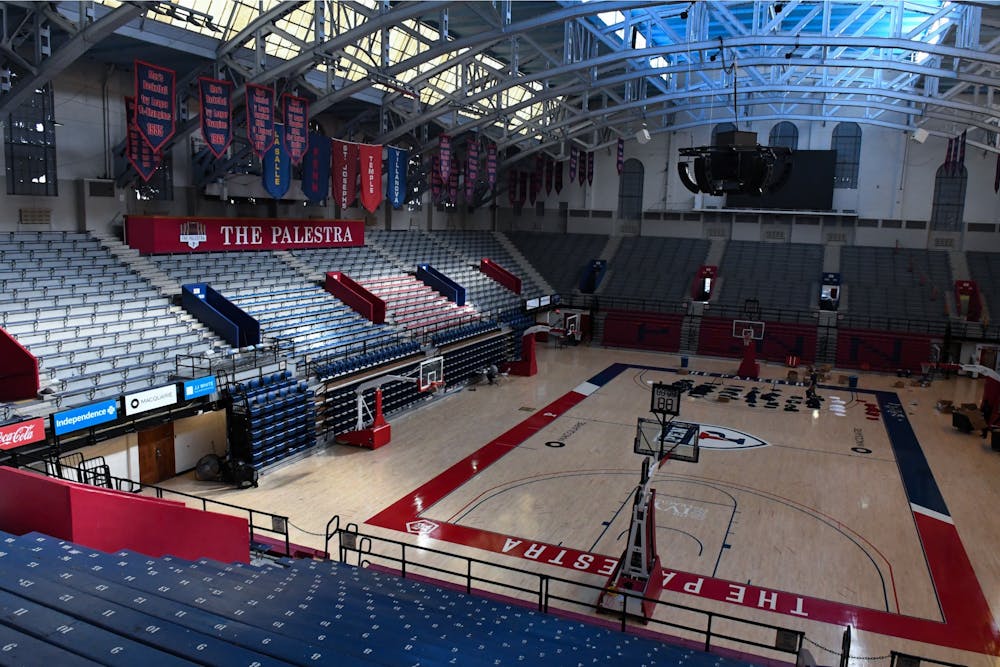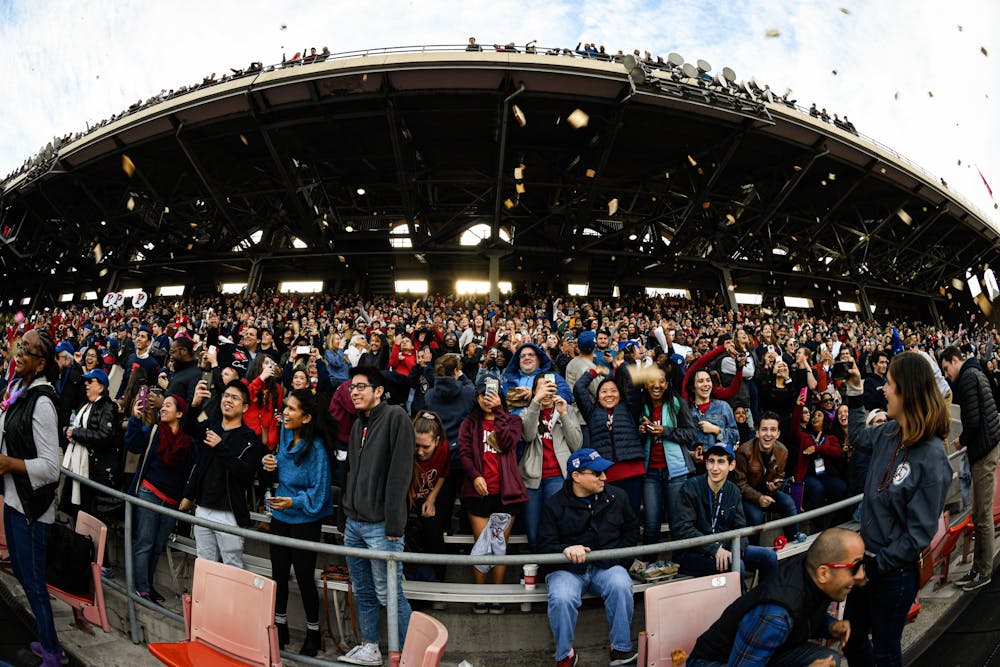
After the third quarter of every football game, Penn students throw toast onto Franklin Field.
Credit: Chase SuttonThe title of this article was originally going to single out freshmen, but, as a result of the pandemic, this year will be many sophomores’ first experience with the Quaker sports world as well. Frankly, a lot of seniors might not know much more about Penn Athletics than they do about nuclear fission or 13th-century Russian literature. But it’s never too late. After reading this list, expect to be a little more fluent in Red and Blue jargon — from the program’s storied past to its ever-changing present.
1. There are 31 sports teams, including one you probably haven’t heard of
Boasting more teams than almost any program in the nation, the Quakers compete in a bevy of traditional sports, from baseball to softball to volleyball to tennis. Additionally, the Red and Blue play their hands at more niche sports, such as golf, fencing, and squash. More unusually, Penn is one of only 10 colleges to compete in sprint football. Formerly known as lightweight football, players are required to weigh 178 pounds or less — yes, even the linemen. Consequently, success in the sport is highly dependent on speed and agility, with less emphasis on the strength and size that is typically prized in traditional football. Altogether, about 10% of Penn undergrads are varsity athletes.
2. Penn plays in the pros
While Penn is traditionally known for placing its students into high-paying finance and tech jobs, its track record in professional sports is not too shabby either. There are currently three former Quakers playing in the NFL, including recent Super Bowl champion Justin Watson. Over in the MLB, Penn pitcher Jake Cousins also recently made his debut on a big league mound. Quaker alumni success even goes beyond the major professional sports leagues, as over a dozen former Penn athletes competed in the Olympics this summer.
3. It’s scandalous … sometimes
In less than four years on campus, Penn’s seniors have lived through quite a few Quaker scandals. Former men’s basketball coach Jerome Allen pleaded guilty in 2018 to accepting bribes to help a fake recruit gain admission to the University. Women’s volleyball coach Iain Braddak, who faced allegations of mistreatment, resigned soon after his final season was abruptly cut short after “offensive posters" were found in the team’s locker room. In fairness, most of Penn’s sports go on without a blip, but the biggest scandals make the loudest noise.

4. A new athletics director is taking the reins
Alanna Shanahan, a former Penn lacrosse player and Penn Athletics administrator, who previously served as the athletics director at Johns Hopkins, started her new job in July. She takes the job from Interim Athletics Director Rudy Fuller, who was filling in for M. Grace Calhoun, who left the role she had held since 2014 to take on the same one at Brown. Shanahan will navigate the Quakers through their first year of NIL while looking to move them into the top tier of Ivy League athletics.
5. The three biggest letters in college sports are N, I, and L
This summer, the NCAA began allowing its athletes to profit off of their name, image, and likeness in a dramatic change of course. While Penn athletes probably won’t be signing multimillion-dollar deals with Adidas, many will still do quite well for themselves. The most recognizable Quakers will have the opportunity to earn tens of thousands of dollars per year through endorsement deals with local businesses. Many of these partnerships will be through social media, so expect to see a lot of your athletically inclined classmates capping their Instagram captions with a #Ad at the end.
6. The Ivy League and its rules
While, today, the Ivy League moniker is synonymous with a top-of-the-line education, it originally started as a premier collegiate sports conference, one that still stands and thrives to this day. Penn is a member of the league, which consists of eight Northeastern schools that are among the oldest in the country — hence the nickname “Ancient Eight” — and compete against each other for sports championships every year. The conference is also known for its stringent and oft-criticized rules and regulations, such as the inability for any student to receive athletic scholarships, and for not allowing graduate students to compete. The Ivy League had among the most restrictive COVID-19 policies in the country, a decision that was maligned by some and praised by others.

7. The most historic stadium in college basketball is on 33rd Street
Purists call it the Cathedral of College Basketball, but you may get a few strange looks referring to it that way during a casual stroll down Locust Walk. The Palestra, named after and inspired by ancient Greek gymnasiums, has a unique layout so that the fans are seated exceptionally close to the court. The venue has hosted more games, teams, and March Madness tournament contests than any other facility in college basketball. Since its 1927 opening, legendary figures such as Lebron James, Kobe Bryant, and AJ Brodeur have scored buckets under its lights. Tickets are free for Penn students, so don’t be surprised if you end up spending a winter afternoon snacking on some crabfries in the only arena where it can be truthfully said that “no seat is a bad seat.”
8. In Philadelphia, the Big 5 is more than just a sporting goods store
Ever since 1955, five Philadelphia colleges — Penn, Temple, La Salle, Saint Joseph’s, and Villanova — all play each other to duke it out for the city crown. In recent years, it has taken a clean sweep to win the title, and Villanova has gone home with six of the last seven championships. The Wildcats’ lone blemish? That belongs to the Quakers of 2018.
9. Have you met Frank?
Nestled right next to the Palestra, Franklin Field (affectionately referred to as “The Frank”) has been home to Penn football since 1895, and it contains almost as much history as its neighbor. The world’s oldest operating college football stadium — and the first with a scoreboard — hosted the Philadelphia Eagles for 13 seasons and was the site of the infamous Santa Claus booing. Other varsity teams practice and play there too, as do many recreational teams. The venue boasts 52,593 seats, although on football game days, it would be lucky to draw a quarter of that number in attendance. This fall, sixth-year coach Ray Priore will look to guide the Quakers back to Ivy League dominance in the stadium, this time with a new quarterback under center.

10. Toast and traditions
Just as one might expect from a school that has been playing sports since Ulysses S. Grant was in office, Penn’s athletic culture is steeped in tradition. Among them include Penn Band’s performance of “The Red and Blue” after games, Homecoming every fall, and the Quakers’ (more recently unrequited) rivalry with Princeton. Most notably, however, is that after the third quarter of every football game, Penn students throw toast onto Franklin Field. Bringing your own toast is not required, but trying to fling it far enough to reach the sideline most certainly is.
The Daily Pennsylvanian is an independent, student-run newspaper. Please consider making a donation to support the coverage that shapes the University. Your generosity ensures a future of strong journalism at Penn.
Donate







